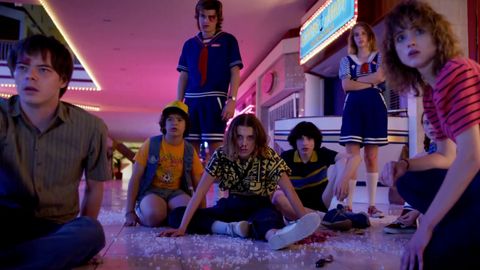GamesRadar+ Verdict
A large cast works well together in a mostly glorious, sometimes outlandish, cocktail of colours and darkness, humour and horror. It’s a ride, and a fun one too.
Why you can trust GamesRadar+
Everyone’s favourite throwback horror series starring a bunch of kids, Stranger Things, is back. Stranger Things season 3 faces a challenge: how do we keep the audience entertained, fulfilled, and - most importantly - scared for not just a second time, but a third?
The show's creators, the Duffer Brothers, certainly grappled with that dilemma in season 2. Offering additional depth to several characters, for example giving Will Byers his long-awaited turn in the spotlight, the second season meandered in places before its sturdy finale that offered just enough to make us excited for another instalment. This reviewer was concerned Stranger Things was getting too light on content and too dark on approach.
Well, the Duffers certainly learned a few lessons. There is precious little meandering in season 3. In fact, there’s hardly a pitstop in sight across the breakneck eight episodes. Kicking off with a brand-new revelation about the horrors facing the inhabitants of Hawkins, Indiana, the show offers us scattergun reintroductions to the cast of characters, which is growing in more ways than one.
No longer precious, innocent pre-teens, the sirens of puberty and adolescence are calling to our teenage cast. Mike and El are now hardly spending a second apart from each other’s faces, much to the displeasure of Eleven’s adoptive dad, Detective Hopper. Lucas and Max are a fiery on-again-off-again couple, and even Dustin, upon returning from science camp, claims to have a girlfriend (who conveniently lives in Utah, of course, which casts a cloud over her actual existence). Meanwhile, Will finds himself as the third wheel everywhere he goes and fails to understand why nobody wants to play D&D with him any more (#JeSuisWill).
New, enriching introductions
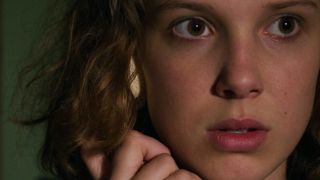
These developing relationships are complemented by a few new characters. Chief among them is Erica, Steve’s (oh our lovable Steve, you’re back and it’s glorious and we love you so much) shift manager at ice cream parlour Scoops Ahoy. Then there's Lucas’s younger, ever-so-persistent sister, Erica, whose role has been expanded. We also get The Princess Bride actor Cary Elwes hamming it up as less-than-moral mayor Larry Kline, which is a treat.
Nancy and Jonathan are back too, now interning at local paper The Hawkins Post. They are bossed around by a bunch of misogynistic creeps, including a criminally underutilised Jake Busey (Starship Troopers). Unfortunately, Winona Ryder’s driven Joyce, along with the character Billy and his stalking cougar, Karen Wheeler, are also not used to their full potential.
It’s in the relationships between these characters that we get a much-needed grounding and human relief – often comic, sometimes dramatic – within the increasingly outlandish and action-driven plot unfolding around them. Yes, those relationships rarely break new ground, with many riffing on well-known emotional tunes. However, the cast members obviously know each other well, and the actors are directed in a way that makes sure the more stereotypical stuff does not bother you for too long. And if the sometimes cliché romances, soon enough you’ll be distracted by the gorgeous visuals.
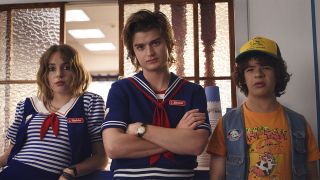
The technicolour ‘80s palette of the sunny, comedic shopping-mall where Steve works offers a unique contrast to the unapologetically gory horror roots of the show. It’s in joining and juxtaposing these two palettes - these two worlds - that the show immerses us into the world of Hawkins, even as the story sometimes challenges our credulence.
Many high-concept shows - especially those that reference past shows, films and well-known tropes as heavily as Stranger Things does - tend to struggle when they have to expand, evolve and adapt an identity of their own. However, the Duffer Brothers must be commended for their audacious, confident approach to season 3. Stuffing perhaps more content into the first half of this season than all of the second, they aren’t afraid to take concepts that are silly, even outlandish, on the surface and run with them. I won’t spoil too much, but the doors are blown wide-open on several ‘established facts’ within the first couple of episodes, and those doors aren’t fully closed even after the season ends. The sense of imminent danger escalates through the season for the inhabitants of Hawkins at large, and beyond, and there’s a real air of menace to the horror sequences, which, yet again, are impeccably designed. The creature design has always been inventive, but, by leaning even heavier into the gore, the Duffers give us some of the shows most visceral horror scenes yet. The sound design and editing is chillingly good, too, and the original score delivers in bunches, especially when things get, erm, squelchy, despite some rather on-the-nose instances of contemporary music at other times.
Full-on from the start
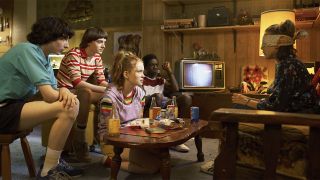
Despite the pacing being much improved from season 2, there's massive expansion in implied scale, which does stretch your suspension of disbelief at times. There is, though, a real sense of purpose to each scene, instead of merely giving characters screentime for the sake of it.
With so many plot strands running in parallel (at least one strand of which is crazier than a bag of squirrels), getting everyone in the cast extended minutes on-screen is a challenge, but it’s balanced well enough with the hectic storyline for it not to bother you too much. The cost of this approach comes early on; the first episode feels scattershot and staccato as it tries to fit everyone in. Yet, as each character gets more exposure in the ensuing episodes, the relationships settle in better, and we can get into the thrill ride.
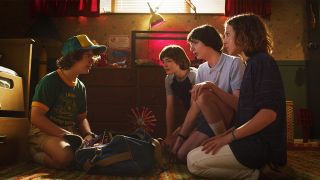
The character who has changed the most between seasons is David Harbour’s Jim Hopper, who until now has been endearingly abrasive but comes off as needlessly aggressive in the first couple of episodes. However, there is a method to that particular madness which is patiently exposed throughout his intra-season arc.
The conclusion to Stranger Things season 3 may feel abrupt, due to its outright frantic pacing, but there is still a good deal of emotional payoff. Remarkably, even though shows like this always tease that they could go on forever, Stranger Things leaves you feeling that now might be a good point to call time on this particular story. It would be good to end a much-loved show on a high.
Erlingur Einarsson is a film reviewer and writer, lover of cinema, television, tractors, and basketball. Erlingur has worked at Future for Plc for five years now, having spent time as the Editor for Photoshop Creative, Operations Editor for Digital Camera World, and Deals Editor for Top Ten Reviews. Erlingur currently serves as the Production Editor for our friends over at Total Film magazine – you should expect to find his byline of film reviews and the hottest of takes.
Most Popular



